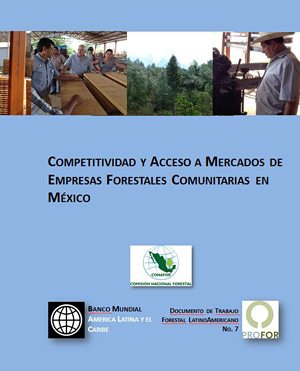green economy

Share
Related Links
Competitividad y Acceso a Mercados de Empresas Forestales Comunitarias en Mxico (junio 2013 PDF)
Strengthening the Value Chain for Indigenous and Community Forestry Operations
Attachments
Guia_para_la_evaluacion_economica_y_financiera_de_proyectos_forestales_comunitarios_en_mexico_1.pdf
MX PROFOR- Competitiveness Report_1.pdf
Authors/Partners
World Bank Latin America and Caribbean Region, CONAFOR, Frederick W. Cubbage, Robert R. Davis, Gregory E. Frey and Diji Chandrasekharan-Behr
Community Forestry Enterprise Competitiveness and Access to Markets in Mexico
CHALLENGE
About one-third of Mexico’s land area is covered by biodiversity-rich native forests, two-thirds of which are considered to have commercial potential. Despite the biological riches and commercial potential, almost 55% of forest-dependent communities are extremely poor. Particular to Mexico, some 80% of forests are owned by indigenous and other communities, giving forest land ownership a strong social nature. Yet Mexico’s forest resources are far from meeting their potential for alleviating poverty and contributing to local development and the national economy. While the Government of Mexico is extremely concerned about conserving the nation’s forest resources and using them sustainably, the forest sector policies and programs do not fully reflect the unique tenure structure of the forests.
Meanwhile, in the last 25 years, numerous Mexican forest communities have managed to develop reasonably successful, commercial community forestry enterprises based on timber and non-timber products. Some of these are among the world’s most advanced examples of commercial community forestry. The large majority of forest communities, however, run less-advanced forest businesses.
APPROACH
While much analysis has been done in the last few years on the economics of community forestry in Mexico and its potential to be competitive, most of this work has been done in isolation from critical stakeholders and has fallen short of generating coherent dialogue and the consensus required to reorient public policy in support of CFEs.
In order to help inform Mexico’s forestry priorities, internal policies, and programs in support of community forestry competitiveness, this activity aimed to develop consensus (through a stakeholder-driven process) on the key constraints and policy actions required to position Mexico’s community forestry sector as a high-value provider to niche markets from sustainably managed community forests, delivering both income and biodiversity protection.
In a two-phased approach, the project would first:
- create a stakeholder participation framework and develop ownership among key stakeholders on the process, outputs and outcomes
- integrate external partners into the process and synthesize their work in this area
- carry out diagnostics and analysis needed to agree upon the priority products and value chains, and
- characterize the current policy and incentive framework of the community forestry sector.
Next the activity would conduct the in-depth analysis needed to develop specific policy, incentive, and public expenditure recommendations to the Government of Mexico and the National Forestry Commission (CONAFOR) to enhance the competitiveness of community forestry.
RESULTS
- Guidelines for financial and economic evaluations for community forestry (Spanish and English versions).
- Training material for financial and economic evaluations for community forestry (Spanish).
- Non-market valuation of forest goods and services: Training presentation (Spanish)
- Toolkit for data capture for community forestry for financial and economic evaluations including: (i) data capture guidelines (Spanish); (ii) data processing spreadsheet (Spanish), and (iii) data capture survey (short and longer version in Spanish)
- Capacity building services to CONAFOR and private and public stakeholders provided to date are: (i) Stakeholder workshop (Nov. 2010); (ii) Stakeholder workshop (July 2011). Data collection training (Mar 2012).
- Financial analysis of 30 selected representative community forest enterprises -- now available in Spanish. The survey touched on topics such as: land equivalent values, profitability of CFEs, forest management, harvesting, sawmills, economic incentives, payments for environmental services, etc.
For stories and updates on related activities, follow us on twitter and facebook , or subscribe to our mailing list for regular updates.
Author : World Bank Latin America and Caribbean Region, CONAFOR, Frederick W. Cubbage, Robert R. Davis, Gregory E. Frey and Diji Chandrasekharan-Behr
Last Updated : 06-16-2024
Share
Related Links
ESMAP's Low Carbon Development Country Studies
External Related Links
Brazil Can Take the Lead in Green Growth, says World Bank (feature story, June 28, 2010)
Keywords
Authors/Partners
Energy Sector Management Assistance Program ESMAP
The Role of Forestry in Low-carbon Growth Strategies
CHALLENGE
Many developing countries are proactively seeking to identify opportunities and related financial, technical, and policy requirements to move towards "green growth" on a low-carbon path. With the support of ESMAP, the multi-donor Enegery Sector Management Assistance Program hosted at the World Bank, selected pilot countries have initiated country-specific studies to assess their development goals and priorities, in conjunction with GHG mitigation opportunities, and examine the additional costs and benefits of lower carbon growth. For some of these pilot countries, addressing issues in the forest and land-use sector play an important role for developing low-carbon growth strategies. Because results have been provided until now in an aggregate manner, a detailed analysis of the forestry and land-use sector have not been separately presented. However, such an analysis would provide important information and guidance to develop low-carbon growth strategies for many other countries where forestry and land-use change are key GHG emissions sources. Such knowledge will be especially important for guiding work in developing countries financed by the World Bank, one of the most important implementing institutions of new programs promoting sustainable forest management for GHG mitigation (FCPF, FIP, BioCF, UN-REDD, etc.)
APPROACH
PROFOR will finance ESMAP's effort to produce a policy brief analyzing the role of forests and forest management for developing and implementing low-carbon growth strategies, including financing options related to low-carbon growth. While the policy brief will build on experience and data analyses already undertaken in key pilot countries (Mexico, Indonesia, Brazil), they will provide general guidance on the integration of forestry in low-carbon growth strategies beyond the case study examples.
The policy brief is expected to serve decision makers and World Bank operations "task team leaders" in developing and implementing forestry-based low-carbon growth strategies for countries with significant GHG emissions from the forestry sector.
RESULTS
This activity is ongoing. Results will be shared on this page when they become available.
For stories and updates on related activities, follow us on twitter and facebook , or subscribe to our mailing list for regular updates.
Author : Energy Sector Management Assistance Program ESMAP
Last Updated : 06-16-2024

Share
Related Links
Adjusted Net National Income data by country
How to calculate Adjusted Net Saving
The Changing Wealth of Nations (World Bank)
Wealth Accounting and the Valuation of Ecosystem Services (WAVES website)
More environment data from the World Bank
Attachments
AGS Final Report on Improved Domestic Timber FINAL(2)_1.pdf
Keywords
data, deforestation, financing SFM, governance, green economy, livelihoods
Authors/Partners
PROFOR, WAVES, RFF
Improving the Forests Database to Support Sustainable Forest Management
CHALLENGE
At the heart of whether growth in a country is green and sustainable is the issue of accumulation of wealth. It is wealth — broadly defined to include manufactured capital, natural capital (including forests), human and social capital— that underlies the generation of national income. Gross domestic product (GDP) has conventionally been used to assess economic performance, measuring economic growth from one year to the next. But GDP does not take into account depreciation and depletion of wealth, and therefore does not provide an indication of whether growth is sustainable: an economy could appear to be growing in the near term by running down its assets such as its forests. Assessments of economic performance should therefore be based on both measures of annual growth (such as GDP) and measures of the comprehensive wealth of a country, which indicate whether that growth is sustainable in the long term.
For the past 15 years, the World Bank has provided indicators to measure the sustainability of a country’s growth path, such as Adjusted Net Saving (ANS), adjusted Net National Income (aNNI), and comprehensive wealth estimates. Underpinning these indicators are data on natural resource rents (from forests, minerals, and energy) which provide policy makers with information on potential revenues from natural capital.
The comprehensive wealth accounts, which have been published for 1995, 2000, and 2005, include estimates for forest wealth which is calculated as the sum of the net present value of rents from timber extraction and annual benefits from non-timber resources, including minor forest products, hunting, recreation, and watershed protection. ANS, which is published annually and covers the period 1970-present, is defined as net national saving adjusted for investments in human capital, depletion of natural resources (including forests), and damages to human health caused by pollution, and provides an estimate of the annual change in wealth.
Recent findings suggest that while wealth data and ANS data are used by researchers and policy analysts, the greatest demand is for data on natural resource rents. However, while minerals and energy rent data have gained a lot of traction, rent data for forests are not used as frequently. Interviews have revealed concerns with the credibility of the underlying data, such as the FAO data on forest area and growing stock. The authors of the indicators have also concluded that a number of methodological changes could improve estimates for forest wealth, potential forest rents, and net forest depletion.
APPROACH
This activity hopes to increase the use of improved World Bank forest data (forest rents, net forest depletion, and forest wealth), so that countries and data users are better equipped with credible and more accurate information on the physical area and value of forest resources. Countries should consider not just the flow of revenues from forest resources, but also the sustainable management of the asset (stock of forest resources).
- Data on the value of forest wealth, its share in total wealth, and how the value is changing over time can help governments assess the contribution of forests to current development outcomes and whether forests are being managed sustainably.
- Data on potential forest rents when combined with information on actual rent recovery and use of these revenues will allow governments to assess whether contribution of forest resources to sustainable development is being realized and who is benefitting from the revenue. Such data and assessments can equip policymakers to better manage forest resources, improve forest governance, increase transparency in the rent captured, and ultimately lead to increased reinvestment of forest rents in other forms of capital to grow the total wealth of the country.
- These policy changes could, in turn, promote the sustainable management of forest resources for poverty reduction and economic growth.
RESULTS
The activity has been successfully completed.
A report is being finalized and will be released soon. The report reviews the latest literature, explores improved data sources, evaluates key parameters and assumptions in the methodology, and outlines the steps and resources required to improve the data and methods.
An implementation plan for updating the forest database that includes a plan for country surveys if the report finds insufficient global data will be finalized in the coming months.
For stories and updates on related activities, follow us on Twitter and Facebook, or subscribe to our mailing list for regular updates
For stories and updates on related activities, follow us on twitter and facebook , or subscribe to our mailing list for regular updates.
Author : PROFOR, WAVES, RFF
Last Updated : 06-16-2024








